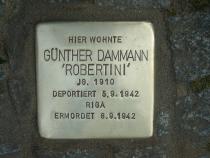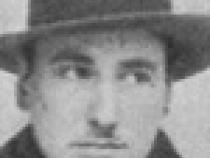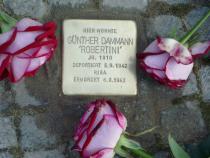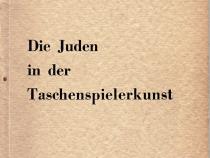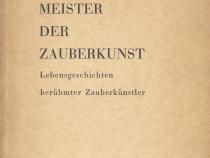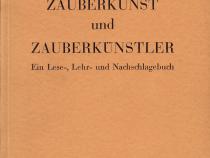Location
Wissmannstr. 17
District
Grunewald
Stone was laid
04 October 2010
Born
08 March 1910 in Berlin
Occupation
Bankangestellter, Autor und Amateurzauberer
Deportation
on 05 September 1942
to
Riga
Murdered
08 September 1942 in Riga
Günther Dammann was born on 8 March 1910 in Berlin. His father, Emil Dammann, owned and managed a private bank. Günther Dammann studied national economy and philosophy in Berlin and Munich before starting work in his father’s bank. When his father died, in 1937, the bank was closed and the family’s household broken up. They gave up their villa in Wissmann Strasse in Berlin-Grunewald. For the 10th edition of Degener’s “Wer ist’s?”, (a German “Who’s Who?”), Günther Dammann described himself as a “bank clerk and scholar”.
While at university, Dammann had joined a Zionist student group. Here he met Professor Heinrich Loewe, who was very active in the German Zionist movement. Loewe later emigrated and became director of the Tel Aviv municipal library (1933-1948). In their occasional correspondence, Dammann wrote to Loewe of possibly emigrating and of his yearning for Palestine, but he stayed in Berlin. The reasons for this are not known.
Conjuring was Dammann’s hobby and his retreat in these difficult times. He had begun performing magic tricks in 1924, at the age of 14. Under the pseudonym Robertini, he performed mainly for friends and acquaintances. He was lucky enough to meet the renowned professional magician Chevalier Ernst Thorn, born in 1853 in Galicia, who had retired to Berlin and became his teacher and mentor. But Dammann was not only an enthusiastic amateur magician who loved “salon magic,” i.e. conjuring in friends’ homes. He also studied the history and theory of magic and wrote books and articles on the subject for reference works and encyclopaedias such as “Der große Herder”, “Das Katholische Deutschland” and “Nordisk Familjebok”. He published his first book in 1933, “Die Juden in der Zauberkunst” (Jews in Magic), which remains a standard work today. He followed it with “Meister der Zauberkunst” (1936) and “Zauberkunst und Zauberkünstler” (1937), both published in Vienna, ironically imprinted with the note that they were “published with the permission of the Reich Literary Chamber”.
In April 1931, Dammann became a member of the Magic Circle and published several articles in the specialist magazine “Magie”. He is last mentioned in the July 1935 issue, in a review of a lecture on the history of magic, broadcast by Königsberg radio. Under the Nuremberg race laws of 1935, Jews were no longer citizens of the Reich and hence could no longer be members of German associations. The Magic Circle made its members reapply for membership – and refused all applications from Jews. By this sleight of hand, the Magic Circle made all its Jewish members vanish.
No precise information is available on Günther Dammann’s last years in Berlin. He left Berlin on a deportation train destined for Riga on 5 September 1942. Shortly after his arrival on 8 September, Günther Damann was murdered in the forest of Bikernieki. To commemorate him, the Berlin Magic Circle had a Stolperstein laid at Wissmann Strasse 17 on 4 October 2010, attended by Mayoress Monika Thieme. It was the 1000th Stolperstein to be laid in the Berlin district of Charlottenburg-Wilmersdorf. The Dammann family’s former home in Grunewald was destroyed in the war.
While at university, Dammann had joined a Zionist student group. Here he met Professor Heinrich Loewe, who was very active in the German Zionist movement. Loewe later emigrated and became director of the Tel Aviv municipal library (1933-1948). In their occasional correspondence, Dammann wrote to Loewe of possibly emigrating and of his yearning for Palestine, but he stayed in Berlin. The reasons for this are not known.
Conjuring was Dammann’s hobby and his retreat in these difficult times. He had begun performing magic tricks in 1924, at the age of 14. Under the pseudonym Robertini, he performed mainly for friends and acquaintances. He was lucky enough to meet the renowned professional magician Chevalier Ernst Thorn, born in 1853 in Galicia, who had retired to Berlin and became his teacher and mentor. But Dammann was not only an enthusiastic amateur magician who loved “salon magic,” i.e. conjuring in friends’ homes. He also studied the history and theory of magic and wrote books and articles on the subject for reference works and encyclopaedias such as “Der große Herder”, “Das Katholische Deutschland” and “Nordisk Familjebok”. He published his first book in 1933, “Die Juden in der Zauberkunst” (Jews in Magic), which remains a standard work today. He followed it with “Meister der Zauberkunst” (1936) and “Zauberkunst und Zauberkünstler” (1937), both published in Vienna, ironically imprinted with the note that they were “published with the permission of the Reich Literary Chamber”.
In April 1931, Dammann became a member of the Magic Circle and published several articles in the specialist magazine “Magie”. He is last mentioned in the July 1935 issue, in a review of a lecture on the history of magic, broadcast by Königsberg radio. Under the Nuremberg race laws of 1935, Jews were no longer citizens of the Reich and hence could no longer be members of German associations. The Magic Circle made its members reapply for membership – and refused all applications from Jews. By this sleight of hand, the Magic Circle made all its Jewish members vanish.
No precise information is available on Günther Dammann’s last years in Berlin. He left Berlin on a deportation train destined for Riga on 5 September 1942. Shortly after his arrival on 8 September, Günther Damann was murdered in the forest of Bikernieki. To commemorate him, the Berlin Magic Circle had a Stolperstein laid at Wissmann Strasse 17 on 4 October 2010, attended by Mayoress Monika Thieme. It was the 1000th Stolperstein to be laid in the Berlin district of Charlottenburg-Wilmersdorf. The Dammann family’s former home in Grunewald was destroyed in the war.







